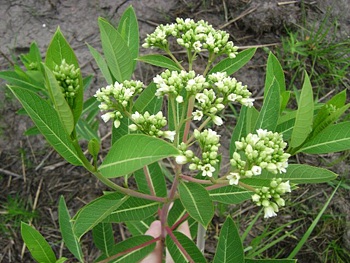Contents:
Common Names | Parts Usually Used | Plant(s) & Culture | Where Found
Legends, Myths and Stories | Uses | Warning | Bibliography
Scientific Names

- Apocynum cannabium L.
- Apocynaceae
- Dogbane family
Common Names
- Hemp
Parts Usually Used
Root, stem, berries, latex
Back to Top
Description of Plant(s) and Culture
Shrub-like; 1-5 feet high. Leaves (except lowermost ones) with definite stalks, 1/2 inches long. The leaves of this plant are oblong and sharp pointed at both ends. Flowers terminal, whitish green, a light pink or purple inside; bell-like, 5-sided, June to August. Seedpods paired; 4-8 inches long. Poisonous to stock but usually avoided because of the bitter, rubbery juice.
This is one of several plants called Indian Hemp.
Back to Top
Where Found
Much of the entire United States. Native to North America. Grows wild in pastures and fields.
Back to Top
Legends, Myths and Stories
Sally bags once were made by the Wasco Indians, an art borrowed from the Nez Perce Indians, who were horse Native Americans. These soft bags were originally saddle bags that had a foundation of Indian Hemp or any of the native milkweeds. The bottoms and top margins were made with woven cedar bark. Indian Hemp was used by the California and Death Valley Indians for bowstrings. String milkweed (Apocynum cannabinum), Indian Hemp, was gathered in the fall. In the fall after the frost comes, the outer bark will fall off, and both this and the inner bark make excellent string. It was stretched and pulled then rolled on the leg; made a handsome string about like fishline, and just as strong. Native Americans used the string to weave nets and ropes.
Cannabis sativa (Hemp): it is illegal to grow this plant without a permit; it is the source of a tough fiber used to produce ropes, and the illegal drug marijuana. (Not Apocynum cannabium) Not Indian Hemp.
Back to Top
Uses
Stems used for fiber, cordage. Milky sap a folk remedy for venereal warts. Relieves dropsy, diarrhea, malaria, migraine, whooping cough, consumption, asthma, acute mania, eczema, dysmenorrhea, delirium tremens, neuralgia, urinary difficulties. Native Americans used berries and root in weak teas for heart ailments; diuretic. Externally, apply poultice to sores, wounds, ulcers, hemorrhoids, orchitis. The seeds, oil and fiber are used for paint, bird preparations, and clothing.
Back to Top
Warning
Contains toxic cardioactive (heart affecting) glycosides. Cymarin and apocymarin have shown anti-tumor activity; the latter also raises blood pressure. Too large a dose will cause vomiting. Use with medical supervision.
Back to Top
Bibliography
![]() Back to Eden
Back to Eden, by Jethro Kloss; Back to Eden Publishing Co., Loma Linda, CA 92354, Original copyright 1939, revised edition 1994
![]() Eastern/Central Medicinal Plants
Eastern/Central Medicinal Plants, by Steven Foster and James A. Duke., Houghton Mifflin Company, 215 Park Avenue South, New York, NY 10000
Herbal Gardening, compiled by The Robison York State Herb Garden, Cornell Plantations, Matthaei Botanical Gardens of the University of Michigan, University of California Botanical Garden, Berkeley., Pantheon Books, Knopf Publishing Group, New York, 1994, first edition
![]() Indian Herbalogy of North America
Indian Herbalogy of North America, by Alma R. Hutchens, Shambala Publications, Inc., Horticultural Hall, 300 Massachusetts Avenue, Boston, Massachusetts 02115, 1973
![]() Indian Uses of Native Plants
Indian Uses of Native Plants, by Edith Van Allen Murphey, Meyerbooks, publisher, PO Box 427, Glenwood, Illinois 60425, copyright 1958, print 1990
![]() American Folk Medicine
American Folk Medicine, by Clarence Meyer, Meyerbooks, publisher, PO Box 427, Glenwood, Illinois 60425, 1973
![]() Webster’s New World Dictionary
Webster’s New World Dictionary, Third College Edition, Victoria Neufeldt, Editor in Chief, New World Dictionaries: A Division of Simon & Schuster, Inc., 15 Columbus Circle, New York, NY 10023
